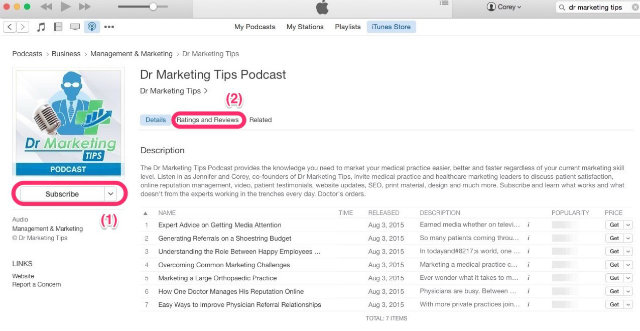 In this Audio Blog, the Dr Marketing Tips team braves the rain and discusses the pros and cons of paying for social media reach for medical practices. We outline how just a few dollars a day can result in a 400 percent increase in engagement and what that means for your practice.
In this Audio Blog, the Dr Marketing Tips team braves the rain and discusses the pros and cons of paying for social media reach for medical practices. We outline how just a few dollars a day can result in a 400 percent increase in engagement and what that means for your practice.
The above audio blog is based off of the original piece of content below.
 Have you noticed a recent drop in your organic reach on Facebook and other social sites? Have you often debated the pros and cons of paying for social media reach for your medical practice?
Have you noticed a recent drop in your organic reach on Facebook and other social sites? Have you often debated the pros and cons of paying for social media reach for your medical practice?
It might be a necessary evil.
The cat is finally out of the bag. Facebook has admitted organic reach is falling short and suggests marketers buy ads to reach their desired fans. In an effort to ensure users have a “meaningful experience on the site”, Facebook has adjusted algorithms to lessen the impact of organic distribution for business pages. In other words, organic (natural) reach on social media is dying and paid reach is the new way to reach your fans.
Many reports say that organic reach now hovers between 6 and 12 percent of the fans you’ve already worked hard to obtain.
In an effort to ensure users have a “meaningful experience on the site”, Facebook has adjusted algorithms to lessen the impact of organic distribution for business pages.
Well played, Facebook. After roping in billions of users and millions of companies across thousands of industries, the jig is up. The free ride is over. At least, that’s what many leading experts and angry bloggers are suggesting. But is it really that bad?
Although organic reach will slowly decline on the site, it does create a few interesting pros and cons when it comes to marketing your medical practice on social media. Yes, all of the other social sites will soon fall in line and begin using similar strategies to provide a back-to-basics user experience and put a few extra dollars in their bank accounts.
Pro: You’re Reaching a Lot More People
It’s important here to state the obvious: when you pay for your audience, you’re going to reach a lot more of them. The great thing about paying for placement on Facebook or Twitter is that all of that hard work you’ve done crafting your content is going to be seen by a lot more eyeballs. This means you’ll be the benefactor of more engagement, more sharing, more brand awareness and, at the end of the day, more appointments.
Best of all, it’s very affordable to reach several thousand targeted potential patients in your area. Take a look at the chart below to see the results of a campaign we just finished putting together for a client.
Case Study:

With this campaign, our goal was to reach sports medicine and allied healthcare professionals in the Central Florida area and encourage them to register for an upcoming seminar. You’ll see that for just under $100, we were able to reach about 15,000 people and generate 144 website clicks to the event’s registration page. At $35 a head to enter, if only three of those clicks turn into registrations, we’ve done something right. Meanwhile, we were putting our client’s office name in front of thousands of new and potential patients, vendors and referral partners in just under seven days.
Pro: Overlapping Goals
Another benefit of paying for reach is accomplishing several of your office’s marketing goals at once. Have you created an ad to encourage website clicks like the example above? This campaign accomplished just that; but it also resulted in 26 new page likes for the practice as an added benefit – a 420 percent increase in likes from the previous week. And by reaching more people, even if they weren’t clicking on the registration page, our client was featured prominently in their News Feed for several days.
Con: You’re Paying for It
Again, stating the obvious here. The downside to paying for reach is that you now have to budget for it if it’s something you want to take advantage of. Sure, you can reach a lot of potential patients for a relatively small dollar amount, but $100 is still $100 any way you slice it. That said, Facebook offers great insight and statistics when it comes to your ad, so you can really measure how well the money was spent when compared to some traditional forms of advertising media.
Con: You get listed as a ‘Sponsored’ on the News Feed
With paid social media ads (sponsored stories and tweets), you’re able to choose whom you’re targeting down to their zip code, interests, age, etc. Great, right? Well, when your ad appears on their feed, it comes with a little “Sponsored” tag. Most people won’t care and they’ll either look or keep scrolling down. However, some may view this as intrusive and vow not to support your practice for interrupting their regularly scheduled cat memes, “Who Are You?” quizzes and photos of freshly-plated meals.
Does Content Still Matter?
You better believe quality, sharable content still matters. That’s the one thing you can rest assured will always play a role in the success of your social media strategy. Photos and interesting posts create better engagement – that’s the way it is. And remember, when you’re paying for reach and your content is bad, a lot more people are going to see that, too.
Subscribing and Rating Our Podcast
If you like what you heard, please take a few seconds and subscribe, rate and review our show on iTunes. Here’s how:
Subscribe
To subscribe, click this link to open iTunes on your computer or press the green “Subscribe” button under the podcast player on this page just above this message. Once you’re in iTunes, you’ll find a “Subscribe” button as denoted by the (1) on the image below. After you’re subscribed, click the “Ratings and Reviews” button (2).

Ratings and Reviews
To leave us a rating and review, select the “Ratings and Reviews” button referenced above (2). Once there, select a star rating for the show (3) and leave your brief review (4).
